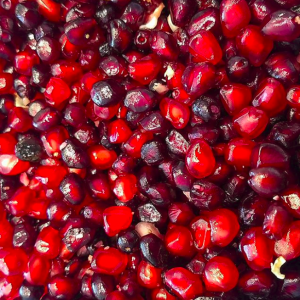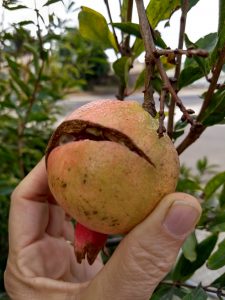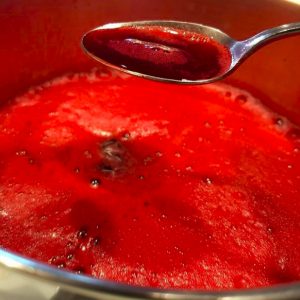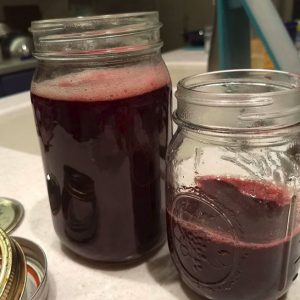Pomegranate Cranberry Sauce recipe
 In the days leading up to Thanksgiving, several people enjoyed my photos on Instagram of pomegranate processing. Some people begged for the recipe.
In the days leading up to Thanksgiving, several people enjoyed my photos on Instagram of pomegranate processing. Some people begged for the recipe.
The original recipe was something my sister made up years ago, to cope with an over-abundant harvest of pomegranates. Since each of us have pomegranate trees, this Pomegranate-Cranberry Sauce has become standard in our family. And boy, is it GOOD!
It does take a bit of labor, however.
To make Pomegranate Cranberry Sauce, you have to start by processing the fresh fruit. Then you have to make the pomegranate molasses. Lastly, you make cranberry sauce.
Pomegranate molasses can be found in Middle Eastern grocery stores. It is a staple product in several cultures. Or, pomegranate molasses can be made from pomegranate juice you buy in a health food store; there are several recipes on the internet. But we homemake it from our fresh fruit.
Here’s how to DIY, for those who are still interested.
Pomegranate Harvesting
 With homegrown pomegranates, you have the option of leaving them on the tree long enough for them to ripen. Most of the ones in the grocery store are picked unripe – that’s why they are so incredibly sour. Really ripe pomegranates get a rich “burgundy wine” flavor that offsets that sour, so they are a delicious combo of sweet and sour.
With homegrown pomegranates, you have the option of leaving them on the tree long enough for them to ripen. Most of the ones in the grocery store are picked unripe – that’s why they are so incredibly sour. Really ripe pomegranates get a rich “burgundy wine” flavor that offsets that sour, so they are a delicious combo of sweet and sour.
The key to ripening pomegranates on the tree is to leave them until the first ones begin to split. That’s when they are at peak.
If you let them go too long (the one in the inset photo is rather far along) they may be attacked by birds, or might grow mold on some of the seeds. (Those seeds that rotted can be picked out. Usually the remainder of the arils are fine.)
I cut mine off the tree with clippers. Otherwise, you can twist them off, the way you would unscrew a lightbulb. This is the time of year when you will appreciate that you pruned your pomegranate tree to keep it relatively short – so that you can reach the fruit.
Pomegranate Processing
Through the years I have tried many different ways to cope with these glorious harvests of ruby-red fruit. This year’s, I must say, was the easiest (and tidiest) by far.
Realize that pomegranate juice stains cloth in a serious way. It’s bright red, and once washed, becomes a nasty grey. So, break out the old garden clothes before you do this. Don’t think “I’ll do it neatly” because your pomegranates will have a different opinion.
RootSimple likes the spanking method (whacking the fruit with a wooden spoon). Here’s their How to Seed a Pomegranate post. Maybe they have more aggressions to work out than I do (ha!) but I tried their way and created a mess. That’s why I turned to the underwater method.
 I followed the instructions at HealthyNibblesAndBits I set a huge bowl of water deep in my kitchen sink and filled the bowl with water. I cut the flower end off the fruit as they describe. Then, one fruit at a time, I’d hold fruit and hands underwater, and crack the fruit open. The arils will sink and the pith will float. Magic! (if your arils float, touch them with your finger to break the water tension, and they’ll sink).
I followed the instructions at HealthyNibblesAndBits I set a huge bowl of water deep in my kitchen sink and filled the bowl with water. I cut the flower end off the fruit as they describe. Then, one fruit at a time, I’d hold fruit and hands underwater, and crack the fruit open. The arils will sink and the pith will float. Magic! (if your arils float, touch them with your finger to break the water tension, and they’ll sink).
This method kept the mess to a minimum, but it does take a lot of time. This step is most pleasant when done with a friend or family member, particularly one you haven’t seen for a while, so you can chat as you work.
Afterward, I washed the arils in a few changes of water, then hand-picked the few bits of larger pith from what was left.
I processed the pomegranate arils through blender & strainer as recommended by HealthyNibblesAndBits and then I was ready to go.
I set about 2-3 cups worth of those gorgeous pomegranate arils aside in the refrig to be used whole in my final product.
Pomegranate Molasses
 If you are working with homegrown pomegranates instead of store bought, TASTE YOUR FRUIT before you dump sugar on it. I used a backyard Meyer lemon, which meant I had a sweeter sour in that department too. HealthyNibblesAndBits used lots more sugar than I did. Here’s the recipe:
If you are working with homegrown pomegranates instead of store bought, TASTE YOUR FRUIT before you dump sugar on it. I used a backyard Meyer lemon, which meant I had a sweeter sour in that department too. HealthyNibblesAndBits used lots more sugar than I did. Here’s the recipe:
6-7 large pomegranates, enough to yield about 9 cups of arils OR use 4 cups (950ml) of pomegranate juice
1/2 cup (100g) + 2 tablespoons sugar **
1/4 cup (50ml) lemon juice (about one medium lemon)
**I think I used perhaps a 1/4cup, basically half of their recommendation.
Stir to combine, and simmer. I followed their instructions for simmering on low temp for an hour. (photo)
Note: the result will be like thickened pomegranate juice. It will not be deeply syrupy like honey or grocery-store molasses. (One year I tried boiling down for that grocery-store texture, and I completely ruined the entire batch. It tasted burnt and awful.)
I allowed the pomegranate syrup to cool, and stored it in mason jars in the refrig. (photo) Since I knew I was using it the next day, I did not do any elaborate canning/cleansing/water bath.
Cranberry Sauce
Meanwhile, I made Cranberry Sauce from grocery-store cranberries. The package instructions call for cranberries, sugar, and water or OJ. Here, you’re going to use your homemade pomegranate molasses for the liquid. Recipe from AllRecipes.com :
12 ounces fresh cranberries
1 cup white sugar
1 cup liquid**
**Here, you’re going to use your homemade pomegranate molasses for the liquid.
Stir to combine, and simmer gently, until all of the berries have popped. Then cool the mixture in the refrig. Cranberry Sauce will thicken on its own as it cools.
When it is serving time: Remember those pomegranate arils you set aside, whole, in the refrig? Fold those gently into your cranberry sauce. My sister uses about a 50/50 ratio – a cup of arils for every cup of cranberry sauce. Serve immediately.
The pomegranates provide a wonderful crunch/pop and a delightful flavor sensation.
Don’t expect leftovers.
Other notes
Pomegranate arils can be frozen, however they will burst. Thus you cannot plan to freeze them and then use them whole upon defrosting. But the flavor is fine if you wish to freeze them for other uses (for instance, delaying the production of your molasses).
Another thing to do with all that pomegranate juice: RootSimple’s Pomegranate Cocktail

